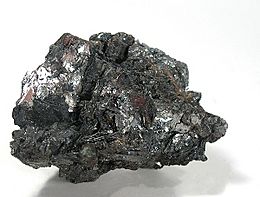Teallite facts for kids
Quick facts for kids Teallite |
|
|---|---|
 |
|
| General | |
| Category | Sulfide minerals |
| Formula (repeating unit) |
PbSnS2 |
| Strunz classification | 2.CD.05 |
| Crystal symmetry | Pbnm (no. 62) |
| Unit cell | a = 4.26 Å, b = 11.41 Å c = 4.09 Å; Z = 2 |
| Identification | |
| Color | Silvery gray, lead-gray to iron-gray; tarnishes dull or iridescent |
| Crystal system | Orthorhombic |
| Cleavage | {001} perfect (lamellar cleavage); flexible |
| Tenacity | Malleable |
| Mohs scale hardness | 1+1⁄2 - 2 |
| Luster | Metallic |
| Streak | Black |
| Diaphaneity | Opaque |
| Specific gravity | 6.36 |
| Optical properties | Anisotropic |
| Pleochroism | Weak |
Teallite is a special kind of mineral. It is made of tin, lead, and sulfur. Scientists call it a sulfide mineral. Its chemical formula is PbSnS2.
This mineral often looks like thin, shiny, silvery-grey plates. These plates are soft, a bit like the mineral mica. Teallite forms in a specific crystal shape called orthorhombic.
Contents
What is Teallite?
Teallite is a mineral that contains lead, tin, and sulfur. It is found deep inside the Earth. It forms in places where hot water flows through rocks. These areas are called hydrothermal veins.
Sometimes, teallite is dug up because it contains tin. This means it can be an ore of tin. An ore is a rock or mineral from which a metal can be taken out.
How Hard is Teallite?
Teallite is quite soft. On the Mohs hardness scale, it scores between 1.5 and 2. This scale measures how hard a mineral is. For example, your fingernail is about 2.5 on this scale. So, teallite is softer than your fingernail!
It also has a specific gravity of about 6.4. This number tells us how dense the mineral is. It means teallite is about 6.4 times heavier than the same amount of water.
Where Was Teallite First Found?
Teallite was first discovered in 1904. It was found in a place called Santa Rosa, Antequera, in Bolivia. This first discovery spot is known as its type locality.
Who Named Teallite?
The mineral was named after a famous British geologist. His name was Jethro Justinian Harris Teall. He lived from 1849 to 1924. Geologists are scientists who study the Earth's rocks and minerals.
Learn More About Minerals
- Different types of minerals
- List of all minerals
- Minerals named after people
 In Spanish: Teallita para niños
In Spanish: Teallita para niños

